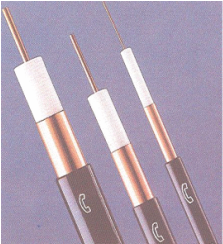Exercise 1.2: Coaxial Cable
The frequency response of a normal coaxial cable of length $l$ (with a diameter of $2.6 \ \text{mm}$ of the inner conductor and an external diameter of $9.5 \ \text{mm}$) is for frequencies $f > 0$:
- $$H(f) = {\rm e}^{-\alpha_{0\hspace{0.02cm}} \hspace{0.05cm} \cdot \hspace{0.05cm} l} \cdot {\rm e}^{-(\alpha_1 + {\rm j}\hspace{0.05cm} \cdot \hspace{0.05cm} \beta_1)\hspace{0.05cm} \cdot \hspace{0.05cm} f \cdot \hspace{0.05cm} l}\hspace{0.05cm}\cdot\hspace{0.05cm} {\rm e}^{-(\alpha_2 + {\rm j}\hspace{0.05cm} \cdot \hspace{0.05cm}\beta_2) \hspace{0.05cm} \cdot \hspace{0.05cm} \sqrt{f} \hspace{0.05cm}\cdot \hspace{0.05cm} l}.$$
- The first term in this equation, arising from the ohmic losses, is described by the so-called kilometric damping $α_0 = 0.00162\, \text{Np/km}$ .
- The frequency-proportional damping component ⇒ $α_1 · f · l$ mit $α_1 = 0.000435 \,\text{Np/(km · MHz)}$ is due to the lateral losses. This only becomes noticeable at very high frequencies and is neglected in the following.
- Also, the frequency-proportional phase $β_1 · f · l$ with $β_1 = 21.78 \,\text{rad/(km · MHz)}$ is left out of consideration because this only leads to an equal transit time for all frequencies.
Hence, for frequencies between $200 \ \text{kHz}$ and $400 \ \text{MHz}$ the frequency response of the coaxial cable is predominantly determined by the influence of
- the damping constant $α_2 = 0.2722 \,\text{Np/(km · MHz}^{0.5})$, and
- the phase constant $β_2 = 0.2722 \,\text{rad/(km · MHz}^{0.5})$,
which are due to the so-called skin effect. For positive frequencies the following applies:
- $$H(f) = K \cdot {\rm e}^{-(\alpha_2 + {\rm j}\hspace{0.05cm} \cdot \hspace{0.05cm} \beta_2)\hspace{0.05cm} \cdot \hspace{0.05cm} \sqrt{f} \hspace{0.05cm} \cdot \hspace{0.05cm} l}.$$
Because of the same numerical values of $α_2$ and $β_2$ this can be expressed as follows:
- $$H(f) = K \cdot {\rm e}^{- \sqrt{2\hspace{0.05cm} \cdot \hspace{0.05cm}{\rm j}\hspace{0.05cm} \cdot \hspace{0.05cm} f/f_0} },$$
where the parameter $f_0$ equally accounts for the two constants $α_2$ and $β_2$ and the cable length $l$ .
Please note:
- This task belongs to the chapter System Description in Frequency Domain.
Questions
Sample solution
- $$K = H(f=0) = {\rm e}^{-\alpha_0 \hspace{0.05cm}\cdot \hspace{0.05cm} l} = {\rm e}^{-0.00162 \hspace{0.05cm} \cdot \hspace{0.05cm} 5}\hspace{0.15cm}\underline{ \approx 0.992}.$$
(2) Mit ${\rm a_0 } = α_0 · l$ müsste folgende Gleichung erfüllt sein:
- $${\rm e}^{\rm -a_0 } \ge 0.97 \hspace{0.2cm} \Rightarrow \hspace{0.2cm} {\rm a_0 } < \ln \frac{1}{0.97 } \approx 0.0305\,{\rm Np}.$$
- Damit erhält man für die maximale Länge $l_{\rm max} = 0.0305 \ \text{Np}/0.00162 \ \text{Np/km} \rm \underline{\: ≈ \: 18.8 \: km}$.
(3) Wegen $β_2 = α_2$ und der angegebenen Beziehung $\rm 1 + j = \sqrt{2j}$ kann für den Frequenzgang auch geschrieben werden:
- $$H(f) = K \cdot {\rm e}^{- \sqrt{2\hspace{0.05cm} \cdot \hspace{0.05cm}{\rm j}\hspace{0.05cm} \cdot \hspace{0.05cm} f \hspace{0.05cm} \cdot \hspace{0.05cm} {\alpha_2}^2 \hspace{0.05cm} \cdot \hspace{0.05cm} l^2} }= K \cdot {\rm e}^{- \sqrt{2\hspace{0.05cm} \cdot \hspace{0.05cm}{\rm j}\hspace{0.05cm} \cdot \hspace{0.05cm} f/f_0} }.$$
- Durch Koeffizientenvergleich mit der vorne angegebenen Gleichung erhält man:
- $${1}/{f_0} = \alpha_2^2 \hspace{0.05cm} \cdot \hspace{0.05cm} l^2 = \big ( \frac { {\rm 0.272} }{\rm km \hspace{0.05cm} \cdot \hspace{0.05cm} \sqrt{MHz} }\big )^2 \cdot ({\rm 5 \hspace{0.05cm} km})^2 = \frac{1.855}{ {\rm MHz} }\hspace{0.2cm} \Rightarrow \hspace{0.2cm} f_0 \hspace{0.15cm}\rm \underline{= 0.540 \: MHz}.$$
(4) Für den Frequenzgang gilt:
- $$\begin{align*}H(f) & = K \cdot {\rm e}^{- \sqrt{2\hspace{0.05cm} \cdot \hspace{0.05cm}{\rm j}\hspace{0.05cm} \cdot \hspace{0.05cm} f/f_0} } = K \cdot {\rm e}^{- \sqrt{ f/f_0} } \cdot {\rm e}^{- {\rm j}\hspace{0.05cm} \cdot \hspace{0.05cm}\sqrt{ f/f_0} } \hspace{0.05 cm} \Rightarrow \hspace{0.05 cm} |H(f)|^2 = K^2 \cdot {\rm e}^{- 2\hspace{0.05cm} \cdot \hspace{0.05cm}\sqrt{ f/f_0} }.\end{align*}$$
- Für $f = f_0$ erhält man hierfür $K^2 \cdot \rm e^{–2} ≈ 0.135$. Daraus folgt weiter:
- $$P_y = P_x \cdot |H(f = f_0)|^2 \hspace{0.15cm}\underline{\approx135\hspace{0.05cm}{\rm mW}}.$$
(5) Mit der höheren Frequenz $f_x = 10\:\text{MHz}$ ist die Ausgangsleistung gegenüber $f_x = 0.54\:\text{MHz}$ signifikant kleiner:
- $$P_y = P_x \cdot {\rm e}^{- 2\hspace{0.05cm} \cdot \hspace{0.05cm}\sqrt{ 10/0.54} }\approx P_x \cdot {\rm e}^{- 8.6 } \hspace{0.15cm}\underline{\approx 0.184 \hspace{0.1cm}{\rm mW}}.$$
